- Home
- About
- Map
- Trips
- Bringing Boat West
- Migration West
- Solo Motorcycle Ride
- Final Family XC Trip
- Colorado Rockies
- Graduates' XC Trip
- Yosemite & Nevada
- Colorado & Utah
- Best of Utah
- Southern Loop
- Pacific Northwest
- Northern Loop
- Los Angeles to NYC
- East Coast Trips
- Martha's Vineyard
- 1 Week in Quebec
- Southeast Coast
- NH Backpacking
- Martha's Vineyard
- Canadian Maritimes
- Ocracoke Island
- Edisto Island
- First Landing '02
- Hunting Island '02
- Stowe in Winter
- Hunting Island '01
- Lake Placid
- Chesapeake
- Provincetown
- Hunting Island '00
- Acadia in Winter
- Boston Suburbs
- Niagara Falls
- First Landing '99
- Cape Hatteras
- West Coast Trips
- Burning Man
- Utah Off-Roading
- Maui
- Mojave 4WD Course
- Colorado River Rafting
- Bishop & Death Valley
- Kauai
- Yosemite Fall
- Utah Off-Road
- Lost Coast
- Yosemite Valley
- Arizona and New Mexico
- Pescadero & Capitola
- Bishop & Death Valley
- San Diego, Anza Borrego, Joshua Tree
- Carmel
- Death Valley in Fall
- Yosemite in the Fall
- Pacific Northwest
- Utah Off-Roading
- Southern CA Deserts
- Yosemite & Covid
- Lake Powell Covid
- Eastern Sierra & Covid
- Bishop & Death Valley
- Central & SE Oregon
- Mojave Road
- Eastern Sierra
- Trinity Alps
- Tuolumne Meadows
- Lake Powell Boating
- Eastern Sierra
- Yosemite Winter
- Hawaii
- 4WD Eastern Sierra
- 4WD Death Valley +
- Southern CA Deserts
- Christmas in Tahoe
- Yosemite & Pinnacles
- Totality
- Yosemite & Sierra
- Yosemite Christmas
- Yosemite, San Diego
- Yosemite & North CA
- Seattle to Sierra
- Southwest Deserts
- Yosemite & Sierra
- Pacific Northwest
- Yosemite & South CA
- Pacific Northwest
- Northern California
- Southern Alaska
- Vancouver Island
- International Trips
- Index
- Tips
- Books
- Photos/Videos
- Search
- Contact
Reykjavik, Iceland
Tuesday, May 30, 2023 - 8:45am by Lolo
50 miles and 0.75 hours from our last stop - 2 night stay
Travelogue
Day 1 - Arrival, Laugardalslaug, and getting an overview of the city
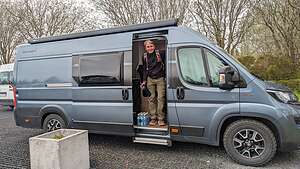 Our home for the next 2 weeksAfter arriving on a red-eye at 8:00 am Iceland time, we stopped in the duty-free store to buy wine and vodka, saving us about 30% on what we would have to pay for it in a liquor store. Liquor is very expensive in Iceland.
Our home for the next 2 weeksAfter arriving on a red-eye at 8:00 am Iceland time, we stopped in the duty-free store to buy wine and vodka, saving us about 30% on what we would have to pay for it in a liquor store. Liquor is very expensive in Iceland.
We then got a cab, which brought us the short 4 miles to McRent to pick up our camper van, where we were given an-hour long instruction on both the van and what to expect in Iceland. It was the same model that we rented for our travels through Spain in 2019 and the Alps in 2017, so we were very familiar and comfortable with it, but I can imagine that there are a lot of mishaps with first timers.
For us, this van was the perfect size - not too big for the narrow streets of Europe, but big enough to be comfortable in and not want to strangle each other. I highly recommend camping as a means to explore Iceland and immerse oneself in the landscape, culture, and local people of a country.
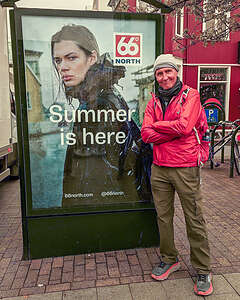 Herb's feelings about Iceland's weatherOne thing we did learn from our briefing though was that Iceland can get very, very windy, especially along the West, so much so that they told us they would text us when it got bad enough for us to stop our driving for the day, or at least slow it down to under 20 mph. We did get a few texts from them, but fortunately we were not in the high wind areas at the time.
Herb's feelings about Iceland's weatherOne thing we did learn from our briefing though was that Iceland can get very, very windy, especially along the West, so much so that they told us they would text us when it got bad enough for us to stop our driving for the day, or at least slow it down to under 20 mph. We did get a few texts from them, but fortunately we were not in the high wind areas at the time.
Before driving to our campground in Reykjavik, we stopped at a Bonus grocery store (which is the biggest supermarket chain in Iceland) to stock up on supplies for the trip. It’s always difficult food shopping in a new country for the first time, as the food choices can be quite different and nothing is where you expect it to be. However, the employees were extremely helpful.
Then it was directly to our campground in Reykjavik for a well-needed nap.
 Iceland, the land of delicious Pylsurs (hot dogs)Reykjavik is where most people start their Iceland vacations, so it was a very well-equipped campground with ample restrooms and showers, a nice cooking and dining facility, and electric hookups.
Iceland, the land of delicious Pylsurs (hot dogs)Reykjavik is where most people start their Iceland vacations, so it was a very well-equipped campground with ample restrooms and showers, a nice cooking and dining facility, and electric hookups.
It was also right next door to Reykjavik’s Laugardalslaug, the town’s public thermal baths and swimming pool complex. Every Icelandic town and village has a pool. I think it’s important for the residents because it is often very cold and rainy here and in the winter there is very little daylight. Plus, the endless geothermal energy makes it possible to provide hot water at little to no expense. Unfortunately, we didn't think photos were allowed in the pool, so we have no pictures.
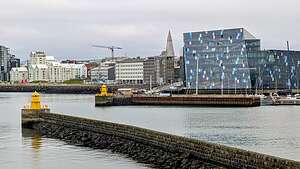 The Harpa Concert Hall from the Old PierThe thermal bath is an Icelandic norm that can be traced back to the early years in Iceland. Icelanders are very passionate about their pools and their hygiene in the pool. Therefore, they have very strict rules before you can step foot in them.
The Harpa Concert Hall from the Old PierThe thermal bath is an Icelandic norm that can be traced back to the early years in Iceland. Icelanders are very passionate about their pools and their hygiene in the pool. Therefore, they have very strict rules before you can step foot in them.
Step #1: Take your shoes off before entering the dressing room and either leave them out front or put them in a locker.
This is where I made my first mistake by trying to shove my entire backpack into what was only meant to be a shoe locker. It locked when I closed it, but when I tried to re-open it to get my bathing suit out, my wristband didn’t work. A very lovely Icelandic woman informed me that I had a blue wristband, which was for lockers in the dressing room, while the shoe locker required a black band to open it. I must have looked really upset, because she volunteered to run to the front desk for me and get a black wristband. I thanked her profusely and told her if she was ever in San Francisco and did something really stupid, I would be happy to help her out.
 The Þúfa (th-oo-fha)I wasn’t even up to the difficult part of the process yet, and I had already messed up.
The Þúfa (th-oo-fha)I wasn’t even up to the difficult part of the process yet, and I had already messed up.
Step #2: Get undressed in the dressing area and lock your clothes and belongings in your locker. Take your bathing suit, towel, and shampoo with you (this is a naked shower), and wash every body part with soap before putting your bathing suit on.
Okay, I almost handled this one, but realized I left my bathing suit in the locker
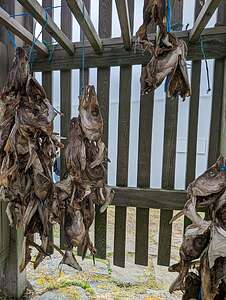 Little hut with dried fish (harðfiskur)Rule #3: Don’t even think about stepping back into the locker room if you are wet, because this will make the floor slippery and upset the locals. Since I had left my bathing suit in my locker, I had to totally dry myself with my little microfiber towel, which took another 5 minutes or so. By now, I was sure Herb was wondering what the heck happened to me.
Little hut with dried fish (harðfiskur)Rule #3: Don’t even think about stepping back into the locker room if you are wet, because this will make the floor slippery and upset the locals. Since I had left my bathing suit in my locker, I had to totally dry myself with my little microfiber towel, which took another 5 minutes or so. By now, I was sure Herb was wondering what the heck happened to me.
Finally, I joined a perplexed-looking Herb in one of the hot tubs. “Don’t ask,” I told him.
Rule #4: Don’t pee in the pool
Okay, I got this one.
By the time we got back to the campground, our friends Hilda and Paul had arrived in their camper. Also, Herb has an Icelandic college buddy (John) that spends his summers in Reykjavik, so he came over to the campground as well.
 Enjoying Íslenski BarinnJohn offered to drive us around Reykjavik in his car to give us an overview of the city and then grab dinner in town.
Enjoying Íslenski BarinnJohn offered to drive us around Reykjavik in his car to give us an overview of the city and then grab dinner in town.
We got the lay of the land on our drive with him, which made our self-guided walking tour the next day much better.
While most of our time was spent in the car, we did get out at the end of the Old Harbor pier to see one of Iceland’s largest artworks called the Þúfa (th-oo-fha). Created by artist Ólöf Nordal in 2013, it is a large grassy mound constructed out of 4,500 tons of gravel, with a winding path circling it all the way to the top and a tiny wooden hut on top.
 Herb and his Icelandic college buddy JohnAfter making our way to the top, we peeked inside the little hut, where we saw dried fish (harðfiskur) hanging. Hardfiskur has been a very popular and healthy snack with Icelanders for centuries. It's full of protein and nutrients.
Herb and his Icelandic college buddy JohnAfter making our way to the top, we peeked inside the little hut, where we saw dried fish (harðfiskur) hanging. Hardfiskur has been a very popular and healthy snack with Icelanders for centuries. It's full of protein and nutrients.
Afterwards, John brought us to one of his favorite restaurants, Íslenski Barinn, a cozy yet lively pub-like setting serving traditional Icelandic food. I was surprised to see puffin on the menu as an appetizer. I very much wanted to see puffins this trip, but not on a crumpet.
As per John’s recommendation, I had the GRATINERAÐUR PLOKKFISKUR (Traditional gratinated fish pie) with cheese, onion, Béarnaise sauce, rye bread & butter.
Herb, the less adventurous eater, had his go to fish and chips. We both thoroughly enjoyed our dinners.
Day 2 - Exploring the city on foot
We had set aside the whole next day to do a self-guided walk of the city. Reykjavik is a beautiful city - clean, safe, and renowned for its culture, history, and natural beauty. There are tons of excellent restaurants serving fresh lamb and seafood, a dozen museums, galleries, and cafes. And you can see an awful lot in a 6.5-mile walk.
While strolling to town along the Sculpture and Shore walk from our campsite, we came to Reykjavik’s famous gleaming steel “Sun Voyager” sculpture, which resembles a Viking long-ship. Vikings, as well as trolls, are a very big part of Iceland’s history and mythology and we would be encountering them (or references to them) all along our journey.
 Harpa Concert CenterWe continued on to the beautiful Harpa Concert Hall, home to the Iceland Symphony Orchestra, Icelandic Opera and Reykjavík Big Band, which hold regular concerts throughout the year.
Harpa Concert CenterWe continued on to the beautiful Harpa Concert Hall, home to the Iceland Symphony Orchestra, Icelandic Opera and Reykjavík Big Band, which hold regular concerts throughout the year.
Harpa was designed by the Danish firm Henning Larsen Architects in co-operation with Danish-Icelandic artist Olafur Eliasson. The structure consists of a steel framework clad with geometric shaped glass panels of different colors, made to look like the crystalline basalt columns commonly found throughout Iceland.
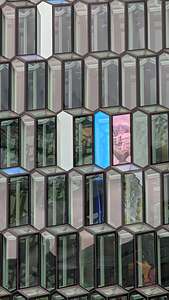 Glass panels of the Harpa CenterThe facade is constantly changing, depending on how the light hits the panels. Reflections of the city and the harbor also often appear and disappear with the light.
Glass panels of the Harpa CenterThe facade is constantly changing, depending on how the light hits the panels. Reflections of the city and the harbor also often appear and disappear with the light.
Reykjavik has 11 museums devoted to history, art, culture, and Vikings, but for some reason we wound up at the Icelandic Phallological Museum. I don’t know how that could have happened. In all fairness, it is the 2nd most popular museum in the city.
Wow! A whole museum devoted to the study and appreciation of mammalian penises. I have no comment.
 Lolo enjoying the Phallological MuseumThe museum, which is also commonly called the Penis Museum for obvious reasons, began as a private collection in 1974 of a man named Sigurdur Hjartson who taught at a school near a whaling station in West Iceland and always seemed to be coming across maritime penises. As a joke, his friends at the station started giving him more. By 1997, when his collection reached an impressive 62 specimens, the Icelandic parliament gave him a grant to establish a public display. What a country!
Lolo enjoying the Phallological MuseumThe museum, which is also commonly called the Penis Museum for obvious reasons, began as a private collection in 1974 of a man named Sigurdur Hjartson who taught at a school near a whaling station in West Iceland and always seemed to be coming across maritime penises. As a joke, his friends at the station started giving him more. By 1997, when his collection reached an impressive 62 specimens, the Icelandic parliament gave him a grant to establish a public display. What a country!
Today, there are over 300 penises from almost all land and sea mammals in Iceland, from a tiny hamster member to a 6-foot-long specimen from a sperm whale.
It’s definitely not just about giggling at penis jokes (although we did have our fair share of that), but actually a serious science museum whose mission is to advance the “ancient science” of Phallology, which examines how male genitalia have influenced history, art, psychology, and literature.
 Enjoying a wiener at Bæjarins Beztu PylsurIn addition to the approximately 300 penis specimens on display, there are also historical artifacts, oddities, and artwork. I went there expecting just to giggle, but I actually learned a lot.
Enjoying a wiener at Bæjarins Beztu PylsurIn addition to the approximately 300 penis specimens on display, there are also historical artifacts, oddities, and artwork. I went there expecting just to giggle, but I actually learned a lot.
Continuing with the wiener theme, we decided to have our first Icelandic Pylsur (hot dog) at Bæjarins Beztu Pylsur, made famous when BIll Clinton had a Pylsur here in 2004. You can’t make this stuff up.
An Icelandic Pylsur is no ordinary hot dog. They are made mostly from Icelandic lamb, along with pork and beef. And not just any lamb, but organic, free range, grass fed, and hormone free. Before becoming a hot dog, these sheep literally roamed the countryside munching on berries and leaves. They pretty much have a better life than us; that is, until they don’t and find themselves in a bun with fried onions, ketchup, mustard, and remoulade.
 Icelandic Street ArtMoving on from wieners, we continued our walk down Laugavegur Street, Reykjavik’s main shopping area with plenty of trendy restaurants, bars, and shops for high-end Icelandic designs and fun souvenirs
Icelandic Street ArtMoving on from wieners, we continued our walk down Laugavegur Street, Reykjavik’s main shopping area with plenty of trendy restaurants, bars, and shops for high-end Icelandic designs and fun souvenirs
It also was a great place to see some examples of Icelandic street art. Because of its relative isolation, street art was slow to come to Iceland, but it has certainly made up for lost time. Starting in the 1990s, artists began covering city buildings, walls, and alleyways with amazing works of art. Many of them can be seen along Laugavegur, the main shopping street.
 Rainbow StreetMy favorite was one called “Ode to Mother,” which totally covered the surface of a shop on Laugavegur 23. Although I would like to pretend that my sons painted this in my honor, this mural was actually painted by Belgian street artist Cara To and inspired by a song of the same name by the Icelandic band Yija.
Rainbow StreetMy favorite was one called “Ode to Mother,” which totally covered the surface of a shop on Laugavegur 23. Although I would like to pretend that my sons painted this in my honor, this mural was actually painted by Belgian street artist Cara To and inspired by a song of the same name by the Icelandic band Yija.
Another interesting one, also on Laugavegur, was inspired by a famous medieval Icelandic saga called Laxdœla Saga, which means that the monster in the mural isn’t a vampire at all; it’s a kind of Icelandic undead creature called a draugur that sucks the will out of its victims.
Hmm..sounds like the dementors in Harry Potter to me.
We continued on to Skolavordustigur, another one of the main streets in downtown Reykjavík, famous for the fact that it has been dressed up in the colors of the rainbow to celebrate Reykjavík Pride. It is a symbol of the Icelandic people's joy and support for diversity.
 HallgrimskirkjaIt leads to the beautiful Hallgrimskirkja Lutheran Church, Iceland’s tallest church. Its beautiful exterior was designed to look like basalt columns to reflect Iceland’s volcanic origins. It really did look like many of the basalt cliffs we would see later in our journey.
HallgrimskirkjaIt leads to the beautiful Hallgrimskirkja Lutheran Church, Iceland’s tallest church. Its beautiful exterior was designed to look like basalt columns to reflect Iceland’s volcanic origins. It really did look like many of the basalt cliffs we would see later in our journey.
The statue on the right is Leifur Eiríksson, the best known hero of Viking age and the first European to arrive in America.
We took an elevator to the top of Hallgrimskirkja’s 75-meter tower where there were panoramic views of the city. In the upper right, is the Harpa Concert Center with the Þúfa hill behind it.
 Reykjavik's Recycled HouseOn our way back to the campground along the Sculpture walk, we decided to continue a bit further, eventually coming to an inviting narrow dirt pathway to what turned out to be one of Reykjavik’s hidden gems - the Recycled House, probably the most unusual site in the entire city.
Reykjavik's Recycled HouseOn our way back to the campground along the Sculpture walk, we decided to continue a bit further, eventually coming to an inviting narrow dirt pathway to what turned out to be one of Reykjavik’s hidden gems - the Recycled House, probably the most unusual site in the entire city.
As we stepped onto the premises , we were greeted by creepy figures in the tall grass.
Once we passed the guardian bogeymen, we came to the Recycled House. It was created by the locally renowned filmmaker Hrafn Gunnlaugsson, who initially purchased the house while he was looking for a workplace to create props for his Viking movies, but later transformed it into an unconventional medley of scrapped metal, timber, and other materials, all of which were incorporated as part of his now redesigned home.
 The Recycled HouseOriginally, every metal sheet that was incorporated into the house featured a lustrous hue. However, following an extended period of time where the building was completely exposed to the elements, exceedingly so due to its proximity to the ocean, most of the metallic color was replaced by orange rust which in turn became the place’s most prominent characteristic.
The Recycled HouseOriginally, every metal sheet that was incorporated into the house featured a lustrous hue. However, following an extended period of time where the building was completely exposed to the elements, exceedingly so due to its proximity to the ocean, most of the metallic color was replaced by orange rust which in turn became the place’s most prominent characteristic.
Despite the house’s iconic and unusual appearance, the city council of Reykjavik didn’t embrace Gunnlaugsson’s creativity at all, treating his residence as an eye sore that needed to be removed.
 Dinner in the Campground Cooking FacilityGunnlaugsson still lives in this house that he worked so hard to create. I only realized afterwards that he is actually sitting in a chair huddled in the doorway.
Dinner in the Campground Cooking FacilityGunnlaugsson still lives in this house that he worked so hard to create. I only realized afterwards that he is actually sitting in a chair huddled in the doorway.
I am so glad we stumbled on this hidden gem.
That night, back at the Reykjavik Campground, we decided to use the cooking facility to make dinner. It was quite fun, mingling with the other campers, each of us struggling to get the burners started. It seemed like everyone else there was half our age. Traveling in a camper van around the country definitely seems to be something done by millennials and not seniors. I’d like to think that we are as hardy and adventurous as millennials.
- 1 of 30
- next ›
Reykjavik location map in "high definition"
Javascript is required to view this map.

